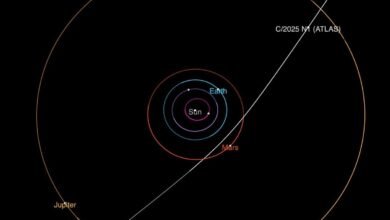Enigmatic Dinosaur Skull Sparks Debate over Tyrannosaur Evolution

January 11, 2024
4 min read
A dinosaur skull first discovered in the 1980s was originally catalogued as a T. rex. Now some scientists argue it represents a new species of tyrannosaur and could shed light on where the massive animals originated

Reconstruction of Tyrannosaurus mcraeensis.
Revisiting a partial dinosaur skull first discovered in the 1980s has some scientists convinced that what was originally catalogued as a Tyrannosaurus rex in fact represents the closest relative of the “king of dinosaurs” ever known. But other paleontologists disagree.
The specimen, which is owned by the New Mexico Museum of Natural History and Science, is physically, geographically and chronologically distinct from the famous dinosaur, museum scientists and their colleagues argue. Instead it belongs to a new species of tyrannosaur, which the researchers have dubbed Tyrannosaurus mcraeensis in a paper published on January 11 in Scientific Reports. “If a T. rex saw this dinosaur, the one we’ve just named, it would have known it wasn’t dealing with a T. rex,” says study co-author Spencer Lucas, a paleontologist at the museum.
Lucas says that a particularly stark difference between the two species comes in the skull’s jaw. “When you look at this jaw, it doesn’t look like the jaw of T. rex,” he says. “The jaw of T. rex is much more massive; it’s shorter and deeper; it’s more robust. This jaw is kind of longer, shallower, a little bit thinner.”
The distinction suggests that this individual was eating different foods than true T. rexes, Lucas and his colleagues note. “This animal was likely feeding differently than the big, car-crunching dinosaur of Jurassic Park,” says study co-author Anthony Fiorillo, a paleontologist and executive director of the New Mexico Museum of Natural History and Science.
Lucas, Fiorillo and their co-authors also note that a bone behind the animal’s eye socket seems to show more ridges than T. rex skulls do. This feature, Lucas says, would have helped tyrannosaurs visually differentiate between individuals of their own and other species.
Other factors also support the premise that the skull could belong to a new species. The animal appears to have been larger than T. rexes known from other fossils. Additionally, it was discovered in New Mexico, whereas most T. rex specimens have come from Montana, Wyoming and South Dakota. And the rock it was found in suggests the animal was alive much earlier than T. rex. “We have an anatomically distinct fossil that’s millions of years older than T. rex,” Lucas says.
If the identification holds up, T. mcraeensis may help scientists understand how tyrannosaurs became such behemoths. Currently, paleontologists are split over whether this group of dinosaurs became massive in Asia—where tyrannosaurs trace their roots and where the closest known relatives of T. rex, Tarbosaurus bataar and Zhuchengtyrannus magnus, roamed—or in the Americas.
Scientists who were not involved in the new research aren’t convinced that these distinctions are substantive enough to merit declaring the specimen a new species, however. T. rex fossils are known for their diversity, says Jared Voris, a paleontology Ph.D. candidate at the University of Calgary in Alberta.
Kat Schroeder, a paleontologist at Yale University, isn’t convinced by the dating evidence the researchers present. She also notes that such a large animal may well have wandered from more northerly states down to New Mexico. “An animal the size of T. rex could potentially have an incredibly massive distribution,” Schroeder says. “There’s no reason to think that T. rex couldn’t have been in New Mexico, just based on its physical size.”
To settle the debate, scientists likely need to find more fossils—bones from the same individual and from other tyrannosaurs found at the same site—which is plausible to do, Lucas says. “There’s a lot of rock out there that we haven’t looked at, and so there’s a lot of potential to find not just more animals like this one but other animals as well,” he says.
Still, the researchers say they’re confident T. mcraeensis deserves its title. “First, we had to convince each other that we were onto something new. Then this paper had to go out for peer review,” Fiorillo says. “This has gone through, if you will, the court system, and the jury has approved that this is a new species. So we’re pretty confident.”
Even if it were a new species, confirming this tyrannosaur is T. rex’s closest relative could be tricky. With ancient species such as these—far too old for genetic material to survive—researchers must resort to so-called phylogenetic analysis, which involves selecting a host of characteristics and then determining which species display them and which don’t. Then a computer program builds a family tree with the smallest possible number of appearances and disappearances of these traits. But that process is as much art as science, experts say.
If future excavations don’t support the identification of T. mcraeensis, Schroeder says that the new description of the specimen and its unusual features will still offer valuable insight into tyrannosaurs. “There’s a lot of really interesting ecology that goes on within a species, especially a species that is so incredibly extreme as Tyrannosaurus rex,” Schroeder says. “Having more specimens of the same species, I think, is just as exciting as naming a new species.”




